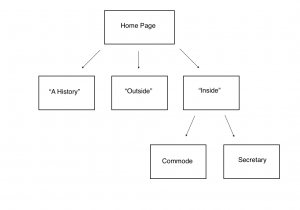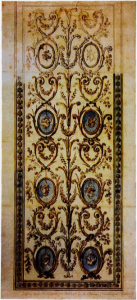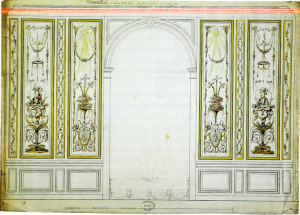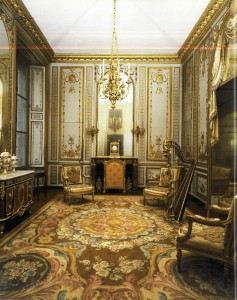Spec Requirements for “A Lacquer World”
Web Developers / Designers: Chloe Foussianes, Sarah Ryder
Position and Goals: Responsible for designing and coding the website, help form the layout according to the needs of the group. The layout will strive to feature user-friendly design and present the data clearly.
Managing/ Copy Editor: Austen Tosone
Position and Goals: checks text to make sure all is written and structured, corrects grammar and spelling, checks facts, citations and resources, looks out for textual problems, checks illustrations to ensure they are correct along with their captions
Project Manager: Julia Flynn
Position and Goals: planning and defining scope of the project, develop schedules, estimating time for the project, managing risks and issues evolving the project, being the point person for all issues or questions, being the liaison between the graduate coordinator as well as Professor Higonnet and Gil, looking into resources for other members of the team if they do not have time to do so, team leadership and monitoring and reporting progress, plus team moral and motivation!!!!
Introduction: The section of this document will provide the overview of the project and purpose. Motto? “ I love my lacquer more than my diamonds.”
- Purpose: The purpose of this document is to detail the requirements for the “A Lacquer World” experience via WordPress. It will detail the development and progress of the site; data & images.
- Scope: Goal is to highlight both the form and function of the black lacquer commode and secretary owned by Marie Antoinette. The WordPress document will explore materials used, function as well as the sentimental value they held to the Queen. Julia Flynn will by use of Photoshop show the two pieces against a black lacquer backdrop (how in actuality they would have been situated) Sarah Ryder will highlight both the form and function of the pieces by creating access digitally to the layers inside of the furniture. Chloe will create an interactive model of the Riesner drop-front desk and commode. The model will allow the user to click on certain elements (perhaps a certain panel of lacquer, or a particular gilt-bronze mount) in order to learn more about them and Austen will be focusing on the idea and analysis of feminine identity during the 18th century using the boxes and the whole idea of privacy and individualism.
- We will explore the possibility of having the user switch the background real-time without having to reload the page. The images for these are included below.
- References: Danielle Kisluk-Grosheide and Jeffrey Munger: The Wrightsman Galleries of the French Decorative Arts: The Metropolitan Museum of Art. Sargentson, “Looking at Furniture Inside Out: Strategies of Secrecy and Security in 18th Century French Furnture. Please see individual pages for full list of references.
- Overall description: The document provides an overview of the system functionality and It will also mention the system constraints. It will also include a motivation for the chosen prioritization methods.
2.1 Product perspective : While the website created will have the potential to function as a self-contained product, it is intended to be used as a supplement to the Metropolitan Museum’s lacquer collection. The website will be focusing on two specific furniture pieces owned by the museum, taking advantage of the digital interphase to provide museum visitors a closer look to the form and function of the commode and secretary.
2.2 Product functions The website will grant users closer access to the lacquer pieces on display in the Tessé Room, by providing detailed images of the surface, compartments, and possible contents, as well as providing a historical and cultural context. The information will be organized into three categories: “a history”, “the outside”, and “the inside”. Together, these categories will function as an educational tool to enhance one’s perception of the objects, showing both how they were both used and created.
2.3 User characteristics The website will cater to visitors to the Metropolitan Museum of Art, especially those who seek additional information on the items displayed in the Tessé Room. By publishing the product online, it will be available as an educational tool to anyone interested in the topic. While the site’s content will be in depth, it can be understood by all user classes, and will not require prior knowledge on the topics discussed.
2.4 Constraints The major constraints to this project are time and technical limitations, as our team is attempting to teach ourselves how to use the necessary software and databases while compiling our research and constructing the website.
2.5 Assumptions and dependence Our project requires high resolution images of the lacquer pieces from the Metropolitan Museum’s database. Additionally, our team plans to use WordPress to host our website, and relies on a premium account in order to customize the html and css to fit our needs. The available and free WordPress templates may limit our design and organization capabilities.
2.6 Apportioning of requirement In the case that the project is not able to be completed in the given timeframe, our website will include less technologically advanced digital components. For example, we will replace our 3-d models with still images, without compromising the informational content.
- Specific User requirements
3.1 User/ Communication requirement: The website will be public and users will be able to view all content anonymously. Because our team will be working together to produce one cohesive product, communication between the various components of the final website will occur through prewritten html and css code.
3.2 Designs specifications.. TBC but our initial wireframe is attached here. — wireframe
- Prioritization and Release Plan
4.1 Choice of method: WordPress The platform that we have chosen to use is WordPress. We believe that using WordPress will allow us to translate our skills in HTML and CSS to our website. In order to ensure that all of the text is consistent, our Managing/Copy Editor, Austen Tosone, will be fact-checking and going through the text to sure that everything is streamlined. The goal is to make sure the tone and the words match the story that we’re trying to tell. The editing process will consist of Austen giving a preliminary edit of just the text and then going back into the site and looking at it in the context of the larger picture.



